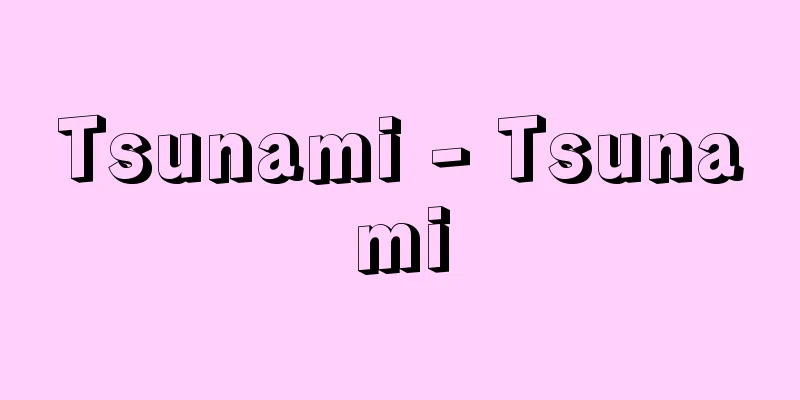Tsunami - Tsunami

|
A wave that is generated mainly by a sudden change in the underwater topography caused by an earthquake and spreads widely through the ocean. It is occasionally generated by large-scale, shocking forces such as the eruption of an underwater volcano, a landslide near the coast, or a nuclear test in the ocean. It can also be observed in lakes. It is not noticeable in the open ocean, but when it propagates to shallow areas along the coast, it increases in wave height and can cause major disasters. It came to be called a tsunami (tsu means port) because it grows abnormally large in ports and bays and goes unnoticed by fishing boats offshore. The word tsunami, which is derived from the Japanese word, is also used as an international term. In the past, high tides caused by typhoons and other events were also treated as tsunamis, and were called storm tsunamis, wind tsunamis, and meteorological tsunamis, while those caused by earthquakes were called earthquake tsunamis. A storm surge is primarily a solitary wave rise in sea level, while a tsunami is characterized by repeated up and down movements of the sea level at cycles ranging from a few minutes to 100 minutes, and can last from a few hours to a few days. [Masami Okada] Tsunami occurrenceDuring an earthquake, sudden slippage occurs on both sides of an underground fault. When a large earthquake occurs at a relatively shallow depth, the range of deformation is large, and the effects can extend all the way to the earth's surface (ocean floor). Crustal deformation during an earthquake progresses rapidly, causing unevenness in the sea surface in a similar manner to the up and down changes in the ocean floor topography, which then becomes a tsunami (long gravity wave) and propagates to the surrounding area. In the case of a landslide on the coast, an impact force acts on the sea surface due to the inflow of soil and sand, generating a tsunami. The speed of a tsunami is roughly proportional to the square root of the water depth, and is expressed as v ≒. Here, v is the tsunami's propagation speed, g is the gravitational acceleration, and h is the water depth. In the ocean at a depth of 4,000 meters, the tsunami is extremely fast at about 200 meters per second, and even in shallow areas near the coast, it reaches about 10 meters per second. The tsunami is faster in deeper areas, so it bends its direction of travel toward shallower areas. The wavelength of a tsunami is determined by the water depth and period, but if the period is 20 minutes, it can be as long as 200 to 300 kilometers in the open ocean. As the energy per wavelength does not change much when a tsunami propagates, the wavelength becomes shorter and the wave height increases when it enters shallow areas. In coastal areas, the effects of wave refraction, diffraction, and reflection are significant, and energy is concentrated and dispersed. In addition, the waveform changes rapidly due to the effects of seabed friction and other factors. For this reason, the height and predominant period of a tsunami vary greatly from place to place, with particularly large waves occurring in places where wave energy is concentrated. Large tsunamis are more likely to occur when there are shallow areas offshore, or in the inner bays of ria coastlines. Furthermore, when the period of the tsunami coincides with the period of the bay's natural vibration (seiche), resonance occurs, resulting in large wave heights in the inner bays. [Masami Okada] Past Great TsunamisLarge tsunamis causing human casualties strike the Japanese coast about once every 10 years. Historically, most coasts in Japan have been hit by large tsunamis, but since the Meiji period, the Sanriku region has been hit more often. In addition to the large number of large earthquakes that occur on the seabed off the coast of Sanriku, the coast is a V-shaped ria coast, so tsunamis are prone to become large in the inner bay where they suddenly narrow. The Meiji Sanriku tsunami of 1896 (Meiji 29) (approximately 22,000 deaths) and the Sanriku tsunami of 1933 (Showa 8) (3,064 deaths and missing) reached more than 20 meters above sea level in the inner bay, causing major disasters. Furthermore, the large-scale tsunami caused by the Tohoku Pacific Ocean Earthquake (Great East Japan Earthquake) on March 11, 2011 (Heisei 23) reached more than 10 meters in various places along the coast from Iwate Prefecture to Fukushima Prefecture. The Great East Japan Earthquake caused enormous damage, including 16,019 deaths and 3,805 missing people (as of October 2011, according to the Fire and Disaster Management Agency), but most of the damage was caused by the tsunami. The coast of the Sea of Japan suffered great damage, including 100 deaths, from the tsunami caused by the Central Japan Sea earthquake in 1983. In addition, the 1993 Southwest Hokkaido earthquake left 230 people dead or missing, about 80% of whom were caused by the tsunami. Tsunamis occur in parts of the Mediterranean and Atlantic Oceans, but are particularly common in the Pacific Ocean and its surrounding areas. The 1960 Chilean earthquake and tsunami caused major damage across the Pacific Ocean, including to the coasts of Hawaii and Japan. In 2004, a massive earthquake off the coast of Sumatra and the resulting Indian Ocean tsunami left more than 220,000 people dead and missing. Tsunamis other than those caused by earthquakes include the 1883 eruption of Krakatoa Island in Indonesia, which created a tsunami 10 to 30 meters high, washing away surrounding villages and killing approximately 36,000 people. In 1792 (Kansei 4), an earthquake caused a massive collapse of Mt. Mayu on the Shimabara Peninsula, which flowed into the Ariake Sea, causing a tsunami that killed approximately 15,000 people. A landslide in Lituya Bay, Alaska in 1958 created a tsunami that reached a height of 525 meters above sea level. [Masami Okada] Observation and countermeasuresTsunamis are mainly observed using tide gauges. Along with normal tides, tide level changes caused by tsunamis and other events are recorded. From these records, the arrival time of the tsunami, the initial movement of the first wave, the wave height (the height from the crest to the trough of the tsunami), and the height of the tsunami measured from normal tides or mean sea level are observed. However, when the height exceeds 2 to 3 meters, tide gauges are often unable to adequately observe. Therefore, water pressure gauges and current meters installed on the seabed, wave height gauges that measure the sea level by emitting ultrasonic waves from the air or seabed, and GPS-based sea level gauges are also used. For tsunami warnings and disaster prevention activities, a lot of observation data is sent to the Japan Meteorological Agency, and when a tsunami strikes, its height is broadcast on television and radio. In addition, special deep-sea tsunami gauges have been developed to detect tsunamis quickly in the open ocean and are deployed around the Pacific Ocean. These played a major role in monitoring and clarifying tsunamis during the Great East Japan Earthquake. After a major disaster occurs, various organizations conduct on-site surveys and measure the height of the tsunami at that location based on tsunami traces. Artificial satellites can measure topographical changes and the extent of inundation. These are also valuable information in clarifying the reality of tsunamis. When a major earthquake occurs and a tsunami is expected to strike, a tsunami warning is issued. Tsunami warning systems are in operation in countries that have suffered major tsunami disasters in the past. In Japan, the Japan Meteorological Agency is in charge of this, and when a tsunami warning or tsunami advisory is issued, it is immediately transmitted to disaster prevention organizations and reported on television and radio. When a tsunami warning is issued, it is important for people on land to quickly evacuate to high ground or other safe places, and for ships in port to move out to sea as far as possible to prepare for the tsunami. When a large tsunami occurs, the front of the wave breaks as it moves forward and attacks as a torrent, which is extremely dangerous. It is often too late to escape after noticing the tsunami. When disaster prevention activities are unavoidable at coasts and ports where there is a risk of a tsunami, wear a life jacket and constantly pay attention to the sea conditions. Note that if the epicenter is close to the coast, a tsunami may strike within a few minutes and the warning may not be issued in time, so if you feel an earthquake on the coast, you need to be on alert for a tsunami immediately. As a measure against tsunamis, signs indicating evacuation routes and evacuation shelters are installed in relatively high-risk areas. Large seawalls (or breakwaters) have been built along the Sanriku coast and other areas, with passageways open in places for people and vehicles to pass through under normal circumstances, but when there is a risk of a tsunami, the passageways and floodgates are closed to prevent seawater from entering. [Masami Okada] Research and studiesTo clarify tsunamis and directly related phenomena such as their generation, propagation and run-up, many tsunami simulations (numerical experiments) are performed using computers. In these simulations, the initial waveform (generation mechanism) is often obtained using an earthquake fault model. The propagation in the ocean is numerically calculated step by step based on the equations of motion of the fluid, and compared with observation data obtained on the coast and offshore. Tsunami simulations are also used for designing seawalls, and are also used to investigate the generation process of tsunamis from observation data. The behavior of tsunamis near the coast is very complex, and in addition to such research, experiments using large hydraulic models are also performed. As a basic investigation, a tsunami propagation diagram is created that shows the propagation from the source area or epicenter. This diagram shows the outline of the propagation time and the concentration and dispersion of energy. Many have been created so far, and are used for tsunami forecasting along with the results of tsunami simulations. Several methods have been proposed for determining the scale of a tsunami, but in Japan the Imamura-Iida tsunami magnitude scale, which divides the scale of a tsunami into six levels from -1 to 4 based on its height on the coast and its affected area, is relatively commonly used. The size of a tsunami is related to the total energy of the tsunami and the area of the source region, and tends to increase as the magnitude of the earthquake increases. An earthquake that is accompanied by a large tsunami despite the fault rupture during the earthquake progressing relatively slowly and the earthquake itself being not very large is called a tsunami earthquake. [Masami Okada] Edited by Wadachi Kiyoo, "Tsunamis, storm surges and marine disasters" (1970, Kyoritsu Shuppan) ▽ "Historical disasters in Japan" by Kikuchi Masao (1980, Kokon Shoin) ▽ "Photographic record of modern Japanese tsunamis" edited by Yamashita Fumio (1984, Seijisha) ▽ "Historical disasters in Japan: Meiji period" by Kikuchi Masao (1986, Kokon Shoin) ▽ "Prediction and disaster prevention of coastal disasters - How to prepare for tsunamis and storm surges" edited by Takahashi Hiroshi, Takeda Atsushi, Tanimoto Katsutoshi, Toji Yoshinobu and Isozaki Ichiro (1988, Hakua Shobo) ▽ "Complete record of the July 12, 1993 southwestern offshore Hokkaido earthquake" edited and published by the Hokkaido Shimbun Press (1993) ▽ "Understanding and Preventing Natural Disasters, 2nd Edition (1996, Kokin Shoin) by Oya Masahiko, Kinoshita Takeo, Wakamatsu Kazue, Hatori Tokutarou, and Ishii Yumio" ▽ "Japan's Danger Zones - Earthquakes and Tsunamis, New Edition (1996, Shinchosha) by Rikitake Tsunetsugu" ▽ "A Guide to Disaster Prevention: The Shaking Earth - How Earthquakes, Tsunamis, and Volcanic Eruptions Work and How to Monitor and Predict Them" (2001, Climb) by Seino Masaaki" ▽ "History of Disasters in Japan, 3 volumes (2001, Japan Library Center) by Shimotsuru Daisuke, Tsumura Kenshiro, Miyazawa Seiji, and others" ▽ "The Latest Edition: A Comprehensive List of Damaging Earthquakes in Japan" by Watanabe Takeo (2003, University of Tokyo Press)" ▽ "Encyclopedia of Tsunamis, edited by Shuto Nobuo et al. (2007, Asakura Shoten)" [References] | | | | |Undersea | | | | | | | | | | | earthquake|Great | | | | |Source: Shogakukan Encyclopedia Nipponica About Encyclopedia Nipponica Information | Legend |
|
おもに地震に伴う海底地形の急変によって発生し海洋を広く伝わる波。まれに海底火山の噴火、海岸付近の山崩れ、海洋上での核実験など、大規模で衝撃的な力によっても生じる。湖などでも観測されることがある。外洋では目だたないが、沿岸の浅い所へ伝播(でんぱ)してくると、波高を増し、大きな災害を引き起こすことがある。沖合いの漁船などでは気づかずに港や湾で異常に大きくなることから、津波(津は港の意味)とよばれるようになった。国際用語としても、日本語から転じたtsunamiが用いられている。過去には台風などによる高潮(たかしお)も津波として扱われ、暴風津波、風津波(かぜつなみ)、気象津波などとよばれ、地震によるものを「地震津波」とよんだ。高潮はおもに孤立波的な海面上昇であるが、津波は数分~100分程度の周期で海面が上下動を繰り返し、数時間から数日間続く。 [岡田正実] 津波の発生地震の際は地下の断層を境にして、両側で急激なずれが発生する。大地震が比較的浅い所で発生すると、変動の範囲が大きく、影響が地表面(海底)まで及ぶことがある。地震時の地殻変動は急激に進行するので、海底地形の上下変化と同様な形で海面の凹凸が生じ、それが津波(重力長波)となって周囲へ伝播する。海岸での山崩れの場合は、土砂等の流入により海面に衝撃的な力が作用し、津波が発生する。 津波の進行速度は水深の平方根にほぼ比例し、v≒で表される。ここで、vは津波の伝播速度、gは重力加速度、hは水深である。水深4000メートルの海洋では毎秒約200メートルときわめて速く、沿岸近くの浅い所でも秒速10メートル前後に達する。深い所のほうが速く、津波が回り込むので、進行方向が浅いほうへ曲がる。津波の波長は水深と周期によって決まるが、周期20分だとすれば、外洋では200~300キロメートルにもなる。津波が伝播する際は、1波長当りのエネルギーがあまり変化しないので、浅い所に進入すると波長が短くなり、波高が大きくなる。沿岸部では、波の屈折、回折、反射などの影響が著しく、エネルギーの集中・発散がおこるとともに、海底摩擦などの効果もあって、波形が急激に変化する。このため、津波の高さと卓越周期が場所によって大きく異なり、波のエネルギーが集中するような場所ではとくに大きな波高となる。海岸の沖に浅瀬が発達している場合や、リアス式海岸の湾の奥は大きな津波になりやすい。また、津波の周期と湾の固有振動(セイシュ)の周期が一致すると共振をおこし、湾の奥では大きな波高となる。 [岡田正実] 過去の大津波人的被害を伴う大津波は、10年に1回程度の割合で日本沿岸に襲来している。歴史的にみると、日本のほとんどの海岸が大津波に襲われているが、明治時代以降では三陸地方に多い。三陸沖の海底で大地震が多く発生することに加え、V字形に切れ込んだリアス式海岸なので急に狭くなる湾奥で津波が大きくなりやすい。1896年(明治29)の明治三陸津波(死者約2万2000人)、1933年(昭和8)の三陸津波(死者・行方不明者3064人)では湾奥で海抜20メートル以上に達して大災害をもたらした。さらに、2011年(平成23)3月11日の東北地方太平洋沖地震(東日本大震災)に伴う大規模津波では、岩手県~福島県沿岸の各地で10メートル以上に達した。この東日本大震災では、死者1万6019人、行方不明者3805人(消防庁発表、2011年10月時点)を含む甚大な被害が発生したが、大部分は津波によるものであった。 日本海沿岸では1983年の日本海中部地震の津波で死者100人を含む大被害を受けた。また、1993年(平成5)の北海道南西沖地震では、230名の死者・行方不明者があったが、その約80%は津波によるものであった。 津波は地中海、大西洋の一部などでも発生するが、太平洋とその周辺にとくに多い。1960年のチリ地震津波は、太平洋を隔てたハワイや日本沿岸にも大きな被害をもたらした。2004年にスマトラ島沖で発生した巨大地震とそれに伴うインド洋大津波では、死者・行方不明者が22万人以上に及んだ。 地震以外の津波では、1883年のインドネシアのクラカタウ島の大噴火で高さ10メートルから30メートルの大津波がおこり、周辺の村々を流失させ、約3万6000人が死亡した。また、1792年(寛政4)島原半島の眉山(まゆやま)が地震を契機に大崩壊して有明海(ありあけかい)に流れ込んだために津波が発生し、約1万5000人の死者が出た。1958年にアラスカのリツヤ湾で発生した山崩れでは津波が海抜525メートルの高さまで達している。 [岡田正実] 観測と対策津波の観測は、おもに潮汐(ちょうせき)観測用の検潮儀で行われている。通常の潮汐とともに、津波などによる潮位変化が記録される。その記録から、津波の到着時刻、第一波の初動、津波の山から谷までの高さを表す波高、平常の潮汐または平均海面などから測定した津波の高さなどを観測する。 しかし、高さが2~3メートルを超えると、検潮儀では十分観測できないことが多い。そこで、海底に設置した水圧計や流速計、空中または海底から超音波を発射して海面の高さを測定する波高計、GPSで海面高度測定するものなども利用されている。津波警報および防災活動のために、多くの観測データが気象庁へ送られ、津波来襲時にはテレビやラジオでその高さが放送される。また、外洋で早急に検知するために、深海で運用する特別な海底津波計が開発され、太平洋周辺部などに展開されている。これらは、東日本大震災時にも津波を監視したり解明するのに大きな役割を果たした。大きな災害が発生した後には、いろいろな機関で現地調査が実施され、津波の痕跡(こんせき)などから、その場所での津波の高さの測定などが行われる。人工衛星では、地形変化や浸水範囲が測定できる。これらも津波の実態を解明するうえで貴重な資料となっている。 大地震が発生し、津波の襲来が予想される場合は、津波警報が発表される。津波警報システムは過去に大きな津波災害を被った国々で運用されている。日本では気象庁が担当しており、津波警報や津波注意報が発表されると、ただちに防災機関へ伝達され、テレビやラジオを通じて報道される。津波警報が発表されたときは、陸上の人は速やかに高台など安全な場所へ避難し、港内にいる船舶はできるだけ沖へ出て、津波に備えることがたいせつである。大津波になると、波の前面が砕けながら進み、激流となって襲ってくるので、きわめて危険である。津波に気づいてから逃げても間に合わないことが多い。津波が襲来する恐れがある海岸・港などで防災活動上やむをえず作業するときは、救命胴衣を着用し、絶えず海の状況を注意しながら行う。なお、震源が海岸に近い場合は、数分以内に津波が襲来して警報が間にあわないこともあるので、沿岸にて地震を感じたら、すぐに津波に対して警戒する必要がある。津波に対する施設として、比較的危険性の高い地域には避難路・避難場所の案内板が設置されている。三陸沿岸などでは大きな防潮堤(または防波堤)がつくられており、平常時は人や車が通れるように所々に通路が開けられているが、津波のおそれがあるときは通路や水門を閉鎖し、海水の浸入を防ぐようになっている。 [岡田正実] 調査と研究津波の発生・伝播および遡上など、津波および直接的に関連する現象の解明のために、コンピュータを用いて津波シミュレーション(数値実験)が数多く行われている。その際、初期波形(発生機構)は地震断層モデルで求めることが多い。海洋中の伝播は流体の運動方程式に基づいて数値的に逐次計算され、海岸および沖合で得られた観測データと比較される。また、津波シミュレーションは、防潮堤の設計などに利用されており、津波の観測データから津波の発生過程を調べることにも活用されている。海岸付近での津波の挙動は非常に複雑で、このような研究とともに、大きな水理模型などを用いた実験も行われている。基本的な調査として、波源域または震央から伝播するようすを示す津波伝播図がつくられる。この図をみると、伝播時間やエネルギーの集中・発散の概略がわかる。これまでに数多く作成され、津波シミュレーションの結果とともに、津波予報に利用されている。津波の規模の決め方はいくつか提案されているが、日本では、海岸での高さと影響範囲から津波の規模を-1から4までの6段階に分ける、今村‐飯田(いいだ)の津波マグニチュードが比較的よく使用されている。 津波の規模は、津波の全エネルギーや波源域の面積に関係があり、地震のマグニチュードが大きくなるにつれて大きくなる傾向がある。地震時の断層破壊が比較的ゆっくり進行し、地震があまり大きくないにもかかわらず、大きな津波を伴う地震を津波地震とよぶ。 [岡田正実] 『和達清夫編『津波・高潮・海洋災害』(1970・共立出版)』▽『菊池万雄著『日本の歴史災害』(1980・古今書院)』▽『山下文男編著『写真記録近代日本津波誌』(1984・青磁社)』▽『菊池万雄著『日本の歴史災害 明治編』(1986・古今書院)』▽『高橋博・竹田厚・谷本勝利・都司嘉宣・磯崎一郎編『沿岸災害の予知と防災――津波・高潮にどう備えるか』(1988・白亜書房)』▽『北海道新聞社編・刊『1993年7月12日北海道南西沖地震全記録』(1993)』▽『大矢雅彦・木下武雄・若松加寿江・羽鳥徳太郎・石井弓夫著『自然災害を知る・防ぐ』第2版(1996・古今書院)』▽『力武常次著『日本の危険地帯――地震と津波』新版(1996・新潮社)』▽『清野政明著『防災への道しるべ 揺れる大地――地震・津波・火山噴火のしくみとその監視・予測』(2001・クライム)』▽『下鶴大輔・津村建四朗・宮澤清治ほか著『日本災害史』全3巻(2001・日本図書センター)』▽『渡辺偉夫著『最新版 日本被害地震総覧』(2003・東京大学出版会)』▽『首藤伸夫他編『津波の事典』(2007・朝倉書店)』 [参照項目] | | | | | | | | | | | | | | | | | | | | | |出典 小学館 日本大百科全書(ニッポニカ)日本大百科全書(ニッポニカ)について 情報 | 凡例 |
Recommend
Kyokuroku
...A type of chair. It is also written as "k...
Masayuki Okada
1864-1927 A Chinese literature scholar from the M...
forest physiognomy
…The shape of the crown also varies depending on ...
Goldschmidt, RB (English spelling) GoldschmidtRB
...Also, when gypsy moths from Japan cross with t...
Alberobello (English spelling)
A town in the province of Bari in the Puglia regio...
Iruma Village
...A city in southern Saitama Prefecture. It stra...
Arm
The use of arms in expressions such as "one&...
Aalst - Aalst (English spelling)
Alost is an industrial city in the northwest of B...
Annamites
…They are written as Yuen Nanjin in Chinese chara...
Miscellaneous duties - Zounin
〘Noun〙 Under the Ritsuryo system, lower-ranking of...
Ukishimagahara
This is a coastal wetland stretching from Fuji Ci...
Rotating disk extraction column
...In a spray tower, the continuous phase is sign...
Masaharu Nishikawa
Experimental physicist of X-ray diffraction and a...
Eenouo - Eenouo
...The spines on its dorsal, anal and pelvic fins...
Zokki book - Zokkibon
A slang term for discounted books. It is also cal...
![Minowa [town] - Minowa](/upload/images/67ccf5258b5ed.webp)








